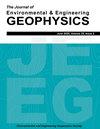Geophysical Reconnaissance for Siting Dryland Critical-Zone Monitoring Experiments in Southern New Mexico, USA
IF 0.7
4区 工程技术
Q4 ENGINEERING, GEOLOGICAL
引用次数: 0
Abstract
A dryland critical-zone observatory is planned on a piedmont setting of the Jornada Experimental Range northeast of Las Cruces, New Mexico, near a ∼10-yr eddy flux covariance tower and vegetation monitoring experiment and a 2-yr old water-uptake rainfall infiltration experiment. We carried out several geophysical surveys to help select sites that minimize geologic complexity for follow up hydrologic and biogeochemical studies that will be conducted by other researchers. First, we conducted a review of regional topography, gravity, and magnetics prior to a site visit and then collected reconnaissance magnetic and electromagnetic data to aid in planning more detailed geophysical site characterization surveys. Our initial topographic analysis using 1/3 arc-second digital elevation models (DEMs) showed the proposed area had an out-of-equilibrium curvature pointing to active erosion and possible faulting. Short-wavelength step-like topographic anomalies in the DEMs were confirmed in LiDAR elevations, and are consistent with erosionally resistant soil horizons in the old alluvial fan deposits. Comparison of 2-D density and susceptibility models based on nearby (3-8 km) hydrostratigraphic studies established that the observed regional gravity and magnetic anomalies were larger than could be modeled with the 2-D structural constraints, and established the station spacing our reconnaissance surveys would require to sample shallow soil variations. Our first site visit confirmed the general fault locations and we identified three outcropping caliche horizons distinct to alluvial channel, proximal splay and distal splay deposits in a several hundred-meter traverse that are consistent with the short-wavelength topographic features. In order to plan additional seismic, radar, gravity, and electrical surveys within a region of such high potential variability, we collected magnetic field and magnetic susceptibility measurements along two profiles at 10-50 m spacing. We found anomalies consistent with two projected faults, as well as other bedrock structures, a result significantly more complex than prior regional hydrostratigraphic mapping had suggested. We also conducted a more limited 0.5 km long ground conductivity survey with 5 m spacing that traversed the rainfall infiltration experiment site and found anomalies that aligned with one of the projected faults. The results showed deep (>6 m) 50 mS/m (milliSiemens/meter) values, indicating moister soils, on the footwall side, dropping to 20 mS/m after crossing the fault, consistent with previous observations that normal faults in the Rio Grande Valley asymmetrically influence fluid flow.美国新墨西哥州南部旱地临界带监测实验选址的地球物理勘测
计划在新墨西哥州拉斯克鲁塞斯东北部Jornada实验范围的山前设置一个旱地临界区观测站,靠近一个约10年的涡流通量相关塔和植被监测实验以及一个2年的吸水量降雨入渗实验。我们进行了几次地球物理调查,以帮助选择地质复杂性最小的地点,以便其他研究人员进行后续的水文和生物地球化学研究。首先,在实地考察之前,我们对区域地形、重力和磁学进行了回顾,然后收集了侦察磁和电磁数据,以帮助规划更详细的地球物理场地特征调查。我们使用1/3弧秒数字高程模型(dem)进行的初步地形分析显示,拟建区域有一个不平衡的曲率,指向活跃的侵蚀和可能的断层。在LiDAR高程中证实了dem的短波长阶梯状地形异常,并且与旧冲积扇沉积物的抗侵蚀土壤层位一致。基于邻近(3-8 km)水文地层研究的二维密度和敏感性模型的对比表明,观测到的区域重磁异常比二维结构约束所能模拟的要大,并确定了我们的侦察调查需要采样浅层土壤变化的站间距。我们的第一次实地考察确认了一般的断层位置,并在数百米的横截面上确定了三个不同于冲积河道,近展斜和远展斜矿床的露头层,这与短波长的地形特征相一致。为了在这样一个高电位变异性的区域内规划更多的地震、雷达、重力和电测量,我们沿着10-50米的两条剖面收集了磁场和磁化率测量数据。我们发现了与两条预测断层以及其他基岩结构一致的异常,结果比之前的区域水文地层填图所显示的要复杂得多。我们还进行了一个更有限的0.5 km长的地面电导率调查,间隔5 m,穿越降雨入渗实验场地,发现了与预测断层之一对齐的异常。结果显示,深部(>6 m) 50 mS/m(毫西门/米),表明下盘土壤较湿润,穿过断层后降至20 mS/m,这与以往的观测结果一致,即里奥格兰德河谷正断层不对称影响流体流动。
本文章由计算机程序翻译,如有差异,请以英文原文为准。
求助全文
约1分钟内获得全文
求助全文
来源期刊

Journal of Environmental and Engineering Geophysics
地学-地球化学与地球物理
CiteScore
2.70
自引率
0.00%
发文量
13
审稿时长
6 months
期刊介绍:
The JEEG (ISSN 1083-1363) is the peer-reviewed journal of the Environmental and Engineering Geophysical Society (EEGS). JEEG welcomes manuscripts on new developments in near-surface geophysics applied to environmental, engineering, and mining issues, as well as novel near-surface geophysics case histories and descriptions of new hardware aimed at the near-surface geophysics community.
 求助内容:
求助内容: 应助结果提醒方式:
应助结果提醒方式:


